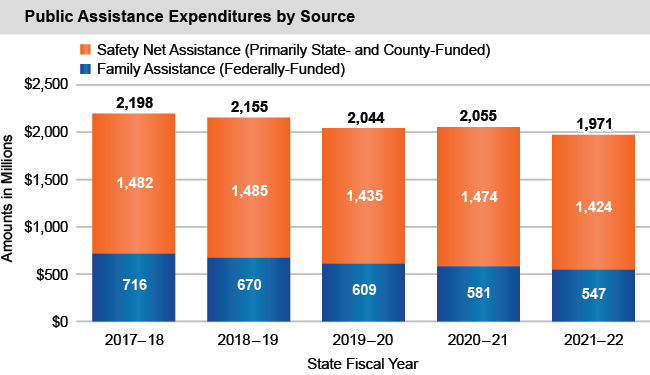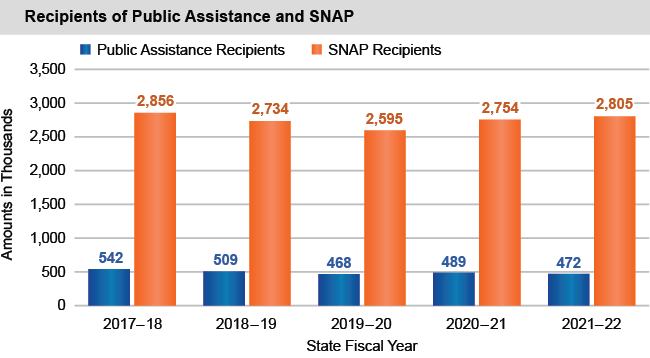Public Assistance Recipients Decrease to Near Record Low
- For SFY 2021-22, the average monthly number of public assistance recipients in the State decreased by 17,043 (3.5 percent) to 472,043, a level slightly higher than the record low of 468,000 in SFY 2019-20.
- “Public assistance” as discussed in this report includes both Family Assistance (FA) and Safety Net Assistance (SNA). FA provides up to 60 months of cash assistance to eligible needy families; SNA provides cash or non-cash assistance to eligible single adults, childless couples, persons who have exceeded the 60-month limit on FA, children living apart from adult relatives and certain other individuals. FA is funded by the federal government, while SNA is largely funded by the State and the counties, and comprises 72 percent of public assistance expenditures.
- The number of FA recipients decreased for the eighth year in a row, by 7.4 percent in SFY 2021-22, bringing the cumulative decline over the eight-year period to 37.2 percent. The number of SNA recipients also decreased, for the fourth time in the last five years, by 1.3 percent, largely due to a decline in areas outside of New York City.
Spending for Public Assistance Falls for the Third Time in Four Years
- Public assistance spending decreased in SFY 2021-22 by $83.7 million (4.1 percent) from the previous year mainly because of a decrease in SNA expenditures in areas outside of New York City.
- SNA expenditures decreased by $50.1 million (3.4 percent) from the prior year.
- FA expenditures in New York State decreased by $33.5 million (5.8 percent) from the prior year.
SNAP Pandemic Spending Surge Continues
- Compared to the prior year, disbursements for the State’s Supplemental Nutrition Assistance Program (SNAP) increased by $2.3 billion (36.1 percent) to $8.7 billion, continuing an upsurge in spending largely related to the pandemic. Over the last two State fiscal years, spending for SNAP, formerly known as the Food Stamp Program and funded by the federal government, has more than doubled, rising from $4.3 billion in SFY 2019-20.
- Much of the increase is due to federal legislation authorizing emergency supplemental benefits to households receiving SNAP and boosting maximum benefits by 15 percent from January through September 2021. New York began issuing the supplemental benefits in March 2020 and will continue doing so as long as the national public health emergency, currently extended until October 2022, remains in effect. The number of SNAP recipients increased for the second consecutive year in SFY 2021-22, but only one-third as much as the prior year.
- Compared to the prior year, the average monthly number of recipients of SNAP benefits in New York State increased by 51,836 (1.9 percent) to over 2.8 million in SFY 2021-22, the highest average number of program recipients since SFY 2017-18.
SSI Recipients Decrease for Sixth Consecutive Year; Disbursements at Their Lowest Level Since SFY 2012-13*
- The average number of recipients of Supplementary Security Income (SSI)—a State- and federally-funded program for the aged, blind and disabled with little or no income and resources—decreased by 22,365 (3.4 percent) to 636,981 in SFY 2021-22.
- Compared to the prior year, SSI disbursements in the State decreased by $81.8 million (1.7 percent) to about $4.9 billion, their lowest level since SFY 2012-13. Of this amount, the federal government contributed $4.3 billion, a decrease of $54.7 million (1.3 percent) compared to the prior year. State expenditures totaled $546.1 million, a decrease of $27.1 million (4.7 percent) compared to the prior year.
* Due to a systems issue affecting SSI reporting, the Office of Temporary and Disability Assistance caseload statistics report for January 2021 did not provide updated SSI recipients and disbursement information. Instead, this report repeated the SSI information provided in the report for the previous month, December 2020. Calculations of the average number of SSI recipients and cumulative SSI disbursements for SFY 2020-21, and the relationship of these calculations to corresponding calculations for SFY 2021-22, reflect this issue.


